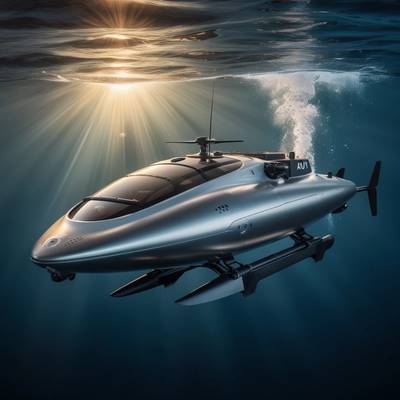The Future of Shipping: Autonomous and Unmanned Marine Vehicles
The maritime industry is on the brink of a revolution, with autonomous and unmanned marine vehicles poised to redefine the future of shipping. These innovative vessels, powered by advanced technologies and cutting-edge propulsion systems, offer numerous advantages, including increased efficiency, reduced operational costs, and enhanced safety. In this article, we'll explore the current state of autonomous marine vehicles, their propulsion systems, and the potential impact they may have on the global shipping industry.
What Are Autonomous and Unmanned Marine Vehicles?
Autonomous and unmanned marine vehicles (AUVs and UMVs) are vessels capable of operating without human intervention. These ships can navigate, avoid obstacles, and perform complex tasks through a combination of sensors, artificial intelligence (AI), and advanced propulsion systems. They range from small, remotely operated vehicles used in research and defense to large cargo ships capable of transoceanic voyages.
Key Technologies Driving Autonomous Marine Vessels
Artificial Intelligence (AI) and Machine Learning
- AI enables autonomous vessels to process vast amounts of data in real-time, making decisions about navigation, speed, and route optimization. Machine learning algorithms allow these systems to adapt and improve over time, enhancing their efficiency and safety.
Advanced Sensors and Communication Systems
- Autonomous vessels are equipped with a variety of sensors, including radar, sonar, LiDAR, and cameras, to monitor their surroundings. These sensors provide data that is processed by onboard systems to detect and avoid obstacles, other vessels, and hazards.
Satellite and IoT Connectivity
- Reliable communication systems, including satellite and IoT networks, are essential for the remote monitoring and control of unmanned vessels. These systems ensure that data is transmitted between the vessel and shore-based control centers, allowing for real-time decision-making and intervention if necessary.
Propulsion Systems in Autonomous Marine Vehicles
The propulsion systems used in autonomous and unmanned marine vehicles are crucial to their performance and efficiency. Several types of propulsion systems are being developed and deployed in these vessels:
Electric Propulsion
- Electric propulsion systems are increasingly popular in autonomous vessels due to their efficiency and lower environmental impact. These systems are typically powered by batteries or fuel cells, which provide a quiet and reliable source of power for long-duration missions.
Hybrid Propulsion
- Hybrid propulsion systems combine traditional internal combustion engines with electric motors, offering the best of both worlds: the range and power of conventional engines with the efficiency and environmental benefits of electric propulsion.
Alternative Fuels
- As the maritime industry seeks to reduce its carbon footprint, alternative fuels like LNG (liquefied natural gas), hydrogen, and ammonia are being explored for use in autonomous vessels. These fuels can provide significant reductions in greenhouse gas emissions compared to traditional marine fuels.
The Benefits of Autonomous and Unmanned Marine Vehicles
Increased Safety
- By removing human operators from potentially hazardous environments, autonomous vessels can significantly reduce the risk of accidents and injuries. Advanced navigation systems and AI-driven decision-making also help avoid collisions and other incidents.
Reduced Operational Costs
- Autonomous vessels can operate 24/7 without the need for crew changes, accommodations, or other human-related expenses. This can lead to substantial cost savings for shipping companies, especially on long-distance routes.
Enhanced Efficiency
- With the ability to optimize routes, speeds, and fuel consumption in real-time, autonomous vessels can achieve higher levels of efficiency than their manned counterparts. This not only reduces costs but also minimizes the environmental impact of shipping operations.
Challenges and Considerations
While the potential benefits of autonomous marine vehicles are significant, there are still challenges to overcome:
Regulatory Hurdles
- The global maritime regulatory framework must adapt to accommodate autonomous vessels. This includes establishing standards for safety, security, and liability, as well as updating existing maritime laws.
Cybersecurity Risks
- Autonomous vessels rely heavily on digital systems and connectivity, making them vulnerable to cyberattacks. Ensuring the security of these systems is critical to the safe and reliable operation of unmanned ships.
Public Perception and Acceptance
- As with any emerging technology, public perception and acceptance are crucial to the widespread adoption of autonomous vessels. Ensuring transparency and demonstrating the safety and reliability of these vessels will be key to gaining the trust of stakeholders.
The Road Ahead
The development of autonomous and unmanned marine vehicles is still in its early stages, but the pace of innovation is accelerating. As technology advances and regulatory frameworks evolve, we can expect to see more autonomous vessels entering service in the coming years. These ships have the potential to transform the maritime industry, making it more efficient, sustainable, and safe.
For shipping companies, the time to start preparing for this future is now. Investing in research, development, and partnerships with technology providers will be essential to staying ahead in this rapidly changing industry. Autonomous and unmanned marine vehicles represent not just the future of shipping but a new era of innovation and possibility on the world's oceans.


















